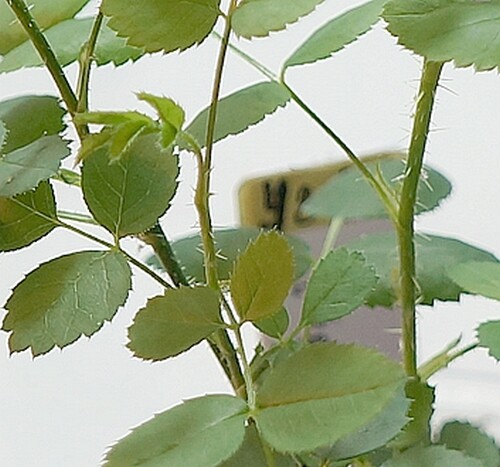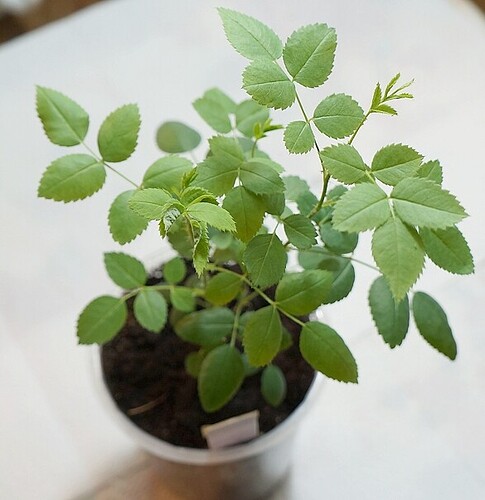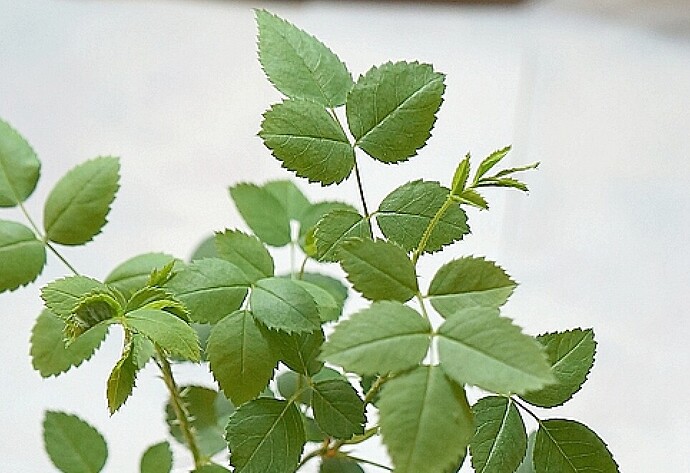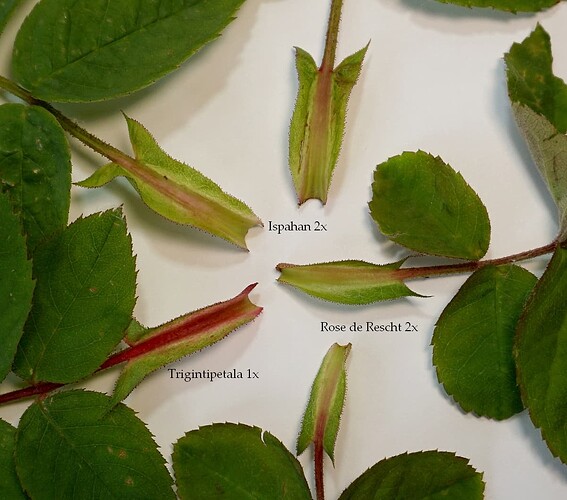I’m interested in purchasing this rose for garden enjoyment and perhaps a possible inclusion in a breeding program ( one day far off- I’m slowly building my number of roses first)- but I was wondering before I commit myself to ordering one for the spring; is rose even suitable for hybridization? I’ve noticed that extreme petal counts kinda hinder pollen, etc, does Ispahan produce any pollen at all? Does it set hips if hand pollinated? I’d just like to know.
I assume that you meant the Damask rose ‘Ispahan’ at that time. In this case, I have noticed and observed over several years, that the seeds of the developed hips have never germinated so far. Even embryo culture as a seed test yielded without exception infected embryos. ‘Ispahan’ produces pollen indeed, but it did not succeed on different mother roses. I still do not give up. This year there again are some seeds in stratification. I will report, if anything should change in my observation.
For me Ispahan has never set hips. It most certainly does not self-pollinate. I’ve assumed it to be sterile both as seed and pollen parent. But maybe I’ve assumed wrong.
But it is one of the finest damasks. Great damask smell and if left unpruned with the right support it climbs up 3 meters high. Maybe more.
I know that we’ve talked about its virtues in other posts, but I’ll add one more good quality to the list–Ispahan is probably the most disease-resistant of the damask roses in climates like mine, with long, hot, humid summers. Its only competition in that regard is possibly Bella Donna, which might be more of a centifolia and is more of a survivor than a truly disease-resistant variety, but it’s hard to really draw a hard line between those classes (not that Ispahan seems at all typical for a damask, either; it might even be some sort of hybrid China). Whatever the actual background, it’s worth any attempt to use in breeding.
Stefan
Oh my… It seems the moment I come to conclusions faith has to kick me in the balls and prove me wrong.
This year I intentionally didn’t prune my Ispahan hoping I would maybe find a hip. But after checking a few months ago, every flower was dried up. Now the leaves have fallen and I’ve found one! And it has one big seed.
The flower itself hung very close to Mme. Isaac Perreire and a little bit further from Léontine Gervais and Tuscany Superb. They all produce much pollen. I’ve also found Mme. Isaac Pereire to match very well with the diploid Schneezwerg. Which surprised me (4 hips from 4 pollinations and about 13 seeds per hip).
I was quite certain Ispahan didn’t produce stamens or maybe very little. It could be self-pollinated. It would be one flower that got pollinated somehow with matching pollen, this of about 250 flowers I had this year on my Ispahan bushes.
I’ll stratify the seed and there is a minuscule tiny chance it would give a seedling. Next year I’ll brush every Ispahan flower with every left over pollen I have.


This is really encouraging–thanks for posting! Maybe the pollen I used just wasn’t a good match, or it just takes more attempts than some other roses. I rather doubt that your seed would have arisen from self-pollination unless it managed to produce a freak flower with drastically fewer petals than normal.
Don’t get in your head too much about a lone seed germinating, though. I’ve succeeded in getting seedlings from single seeds produced after pollinating until I was practically blue in the face. A little hope can be a dangerous thing, but after seeing this, I’m going to give Ispahan another shot next year. Maybe I should invest in a groin cup first…
Pollinating Ispahan shouldn’t be that much of a hassle, because it probably never self pollinates. You shouldn’t really have to prepare the flower I think. Just take a stem with flowers label it and pollinate all the flowers directly. You can still enjoy the flowers. You could pollinate the whole bush with a few types of pollen without hardly any work.
You should have at least a few hips. That’s what I’ll try next year.
I agree–I only meant that the anthers are completely buried in those tightly packed petals, which pretty much eliminates the possibility of self-pollination. The stigmas are pretty accessible, and I didn’t have to destroy any blossoms, but apparently they didn’t want to accept the pollen that I was using in 2021 (it was otherwise pretty fertile, and worked well on most other roses, except for picky ones like Schneezwerg). Unfortunately, I didn’t bother to try pollinating Ispahan this past season.
Update:
This year I managed to get two germinated OP seedlings of ‘Ispahan’. Both germinated on the same day, 19.02.2023. Regrettably, one has stopped growing. There has been no hope of change in status. The other one is thriving well (see photos).The previous 0.2 liter cup was well rooted, so I repotted the seedling into a larger pot. I’ll keep me fingers crossed that health and growth stay that way. As already reported of previous years, every targeted crossing attempts with ‘Ispahan’ were also this year unsuccessful. Naturally, I will keep you posted on the progress.

That is very exciting! I also believe i have ispahan as i received a mislabeled rose from one of the nurseries i purchased from (was trying to get comtesse de murinaise). I did some digging and came to the conclusion the rose i actually received is ispahan. I want to try to work with it, im looking forward to seeing your results!
Thank you for the prompt feedback. I’m glad to have another comrade in arms. I guess @KarelBvn also wants to work more intensively with ‘Ispahan’ this year. Maybe we can decipher a little bit of the question fertility / sterility of this beautiful rose.
Out of curiosity I’ll pollinate as many flowers on Ispahan as I can manage. Simply to see what the potential is. I thought it to be completely infertile untill I accidentally found a hip last year with one big seed. This seed however hasn’t germinated (yet). I don’t expect it to do so, but I’ll give it some more time. I’ll keep you posted.
It’s a lovely seedling you got there. It’ll probably take a few years until you’ll be able to see it flowering. Non-repeaters take a lot of patience to breed. I’ve some this year that’ll probably flower for the first time in 3-4 years. ![]()
What will you use as pollen parent?
Some sources think Ispahan maybe is a Damask x China cross. This could implicate it’s maybe triploid. I’m guessing a repeating tetraploid with some merit as a usefull pollen parent would be a good choice.
I’m thinking of Queen Elizabeth or Julia Child. Maybe Comte de Chambord. It gave me good results as father this year and it is probably close related to damask. These I have readily available in my garden.
I have tried Comte de Chambord without success. Queen Elizabeth or Julia Child are indeed worth a try. For those who have more space, I would recommend ‘Geschwinds Nordlandrose’ as pollen parent. According to DNA studies, this rose also carries Rosa x damascena blood.
So I continue with my previous attempts, i.e. Rose de Rescht, Indigo, Comte de Chambord, Trigintipetala and several own Portland seedlings. All the other roses available to me at the moment do not fit with Ispahan at all.
One more follow-up on my shared OP-Ispahan seedling: In the vicinity of Ispahan there is Rose de Rescht and Triginipetala, little further away rugosas and few Hybrid Tea’s and dark English Roses. It is difficult to spot the pollen dispenser.
Last but not least:
This statement I see critically. The reason is that I always look at the stipules as a reliable indication for the influence of China-blood in general. Therefore, in my main crosses between OGR and modern roses I frequently observe stipules being somewhat more laciniated than in the original OGRs. The more dominant the China-blood influence is, the stipules are slit more longer and stronger. In most cases there are only very small nuances that can be detected with high magnifying glasses at all.
If my thesis is not completely off-base, Ispahan would not contain China blood, because the stipules looks the same as the other shown roses of the Rosa x damascena group.
I have attached two sample images:
How are the seedlings looking?
Well, the seedlings of the F1 generation are, as always and also in this case, a compromise between father and mother, because the hereditary traits of both parents are located unchanged next to each other. It is a kind of mechanical mix, so sometimes it is rather difficult to see clear demarcations. Mostly, the dominant traits show up, the recessive ones remain hidden until a second generation. Sometimes you’re lucky and you will find a desirable recessive characteristic already in the F1. When the OGR genes predominate, the rose will be summer-flowering and does not bloom in the first year. If the influence of R.chinensis is stronger, which is more sporadic, the seedling will be flowering already in the first year and will be repeating throughout the season.
There are also some hybrids that do not bloom in the first year but are good repeaters from that point in the second year. Of course, the growth type also varies greatly. My experience has shown that the typical Portland habit (short-stemmed flowers and straight, compact growth) are recessive traits because the growth habit of the other parent often predominates. With a greater proportion of R. chinensis influence, I sometimes see a heavy susceptibility to powdery mildew, a continued cultivation is not really advisable in this case. Most of the time, an intense susceptibility persists, while mild susceptibilities disappear. In general, the development of these hybrids needs a little more patience and observation. It can be said that each breeding year contains only a very few seedlings remaining, which embody a good balance of both parent strains and are worth going through further selections. Therefore it is always a challenge to find the best compatible mix between OGRs and Modern Roses by choosing the right genetic material, but I’m happy to do the job year by year.
The second seedling of ‘Rose de Rescht’ X ‘The Squire’, 2022 did not bloom until now. It is clearly much more tender in growth and habit as the sibling of the year 2017 but is still in the selection process.
Regarding some further examples I would like to refer you to:
Wow, so beautiful! Amazing work
I had about 10 seedlings Bad Worishofen x Comte de Chambord. All had mildew from early on, but also are very strong growers with large leaves. No bloom in first year also. I’m down to the 4 strongest. But chances are I’ll end up with one or no seedlings.
The Portland repeat must be another repeat than the China repeat. My other Portland x floribunda are also no first year bloomers and I also had almost no healthy offspring.
So about Ispahan. As promised I 've put all of my left over pollen of repeating modern roses on as many flowers of Ispahan as I could. The hips are starting to drop, but I could be imagining, I think there are also hips setting. I’ll send an update in a month or so. I’m moderately optimistic. ![]()
Very excited to hear about any parents of the hips that hold!
Many thanks for sharing all your valuable informations.
I did it similary, but took pollen of OGRs as well. We will see whether Ispahan with our combined forces of a targeted pollination will bear fruits after all or whether the insects ultimately do the better job. I am very curious about our later analysis. ![]()





